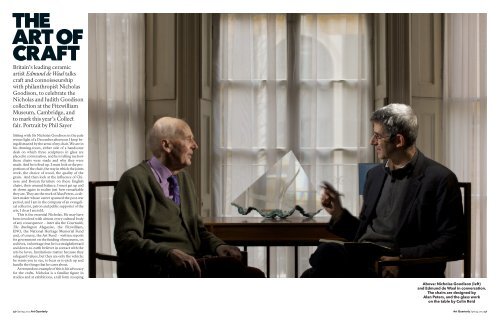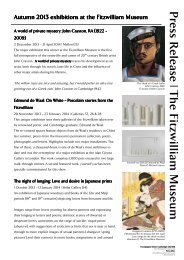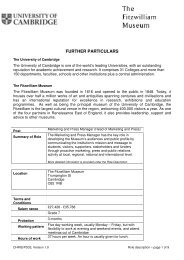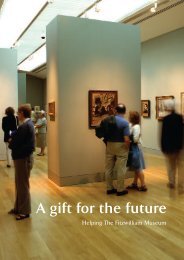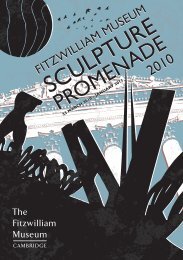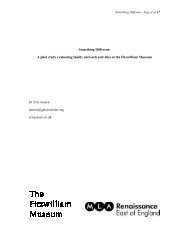THE ART OF CRAFT - The Fitzwilliam Museum
THE ART OF CRAFT - The Fitzwilliam Museum
THE ART OF CRAFT - The Fitzwilliam Museum
Create successful ePaper yourself
Turn your PDF publications into a flip-book with our unique Google optimized e-Paper software.
<strong>THE</strong><br />
<strong>ART</strong> <strong>OF</strong><br />
<strong>CRAFT</strong><br />
Britain’s leading ceramic<br />
artist Edmund de Waal talks<br />
craft and connoisseurship<br />
with philanthropist Nicholas<br />
Goodison, to celebrate the<br />
Nicholas and Judith Goodison<br />
collection at the <strong>Fitzwilliam</strong><br />
<strong>Museum</strong>, Cambridge, and<br />
to mark this year’s Collect<br />
fair. Portrait by Phil Sayer<br />
Sitting with Sir Nicholas Goodison in the pale<br />
winter light of a December afternoon I keep being<br />
distracted by the arms of my chair. We are in<br />
his drawing-room, either side of a handsome<br />
desk on which three sculptures in glass are<br />
placed in conversation, and he is telling me how<br />
these chairs were made and why they were<br />
made. And he is fired up. I must look at the proportions<br />
of the chair, the way in which the joints<br />
work, the choice of wood, the quality of the<br />
grain. And then look at the influence of Chinese<br />
and Korean furniture on these English<br />
chairs, their unusual balance. I must get up and<br />
sit down again to realise just how remarkable<br />
they are. <strong>The</strong>y are the work of Alan Peters, a cabinet-maker<br />
whose career spanned the post-war<br />
period, and I am in the company of an evangelical<br />
collector, patron and public supporter of the<br />
arts. I do as I am told.<br />
This is the essential Nicholas. He may have<br />
been involved with almost every cultural body<br />
of any consequence – inter alia the Courtauld,<br />
<strong>The</strong> Burlington Magazine, the <strong>Fitzwilliam</strong>,<br />
ENO, the National Heritage Memorial Fund<br />
and, of course, the Art Fund – written reports<br />
for government on the funding of museums, on<br />
archives, on heritage; but he is a straightforward<br />
and down-to-earth believer in contact with the<br />
arts he loves. Institutions matter because they<br />
safeguard values, but they are only the vehicle:<br />
he wants you to see, to hear or to pick up and<br />
handle the things that he cares about.<br />
A tremendous example of this is his advocacy<br />
for the crafts. Nicholas is a familiar figure in<br />
studios and at exhibitions, a tall form stooping<br />
Above: Nicholas Goodison (left)<br />
and Edmund de Waal in conversation.<br />
<strong>The</strong> chairs are designed by<br />
Alan Peters, and the glass work<br />
on the table by Colin Reid<br />
40 Spring 2013 Art Quarterly Art Quarterly Spring 2013 41
Nicholas Arroyave-Portela<br />
Crumpled Vase, 2000 (right)<br />
‘Arroyave-Portela is a<br />
young maker whose innovative<br />
work suggests interesting future<br />
developments’<br />
Nicholas Goodison<br />
Martin Smith<br />
White Noise III, 2001 (below)<br />
‘Smith is an established maker,<br />
with a keen interest in the theory<br />
of perspective, whose use<br />
of colour and reflective surfaces<br />
on his non-functional vessels is<br />
fascinating’ NG<br />
down over a pot, quizzical and intrigued in<br />
equal measure. I have been on the receiving<br />
end of his scrutiny: my early porcelain was interrogated<br />
at the Chelsea Crafts Fair 20 years<br />
ago and I remember the seriousness of his questions<br />
as he picked over my stand. He ran big<br />
companies I was told sympathetically by a bohemian<br />
maker of scarves, as he moved off into<br />
the crowds. And then he came back and bought<br />
something and I felt I had arrived, because it<br />
was not a whimsical purchase but a real decision.<br />
For his interest in the crafts is unstinting,<br />
but it is not wide-eyed. He has no romanticism<br />
about the place that the crafts hold in relation to<br />
the other arts – no chair of the Crafts Council<br />
faced with the internecine arguments for funding<br />
could have been – but neither does he adhere<br />
to the Embattled Camp of Craft which insists<br />
on hyperactive cheer-leading. <strong>The</strong> case for<br />
craft is made, he says, through the excellence of<br />
the object and the clarity of its presentation to<br />
the world. This is why he relishes the relationship<br />
that the Art Fund has established with<br />
regional museums at Collect, the annual art fair<br />
for objects, organised by the Crafts Council.<br />
Curators must choose the object which they<br />
would love to have for their collection and then<br />
make their case, passionately and cogently,<br />
in front of the object itself to a committee who<br />
must decide if X gallery needs a piece of Japanese<br />
jewellery, or Y museum should add to<br />
their glass collections. This is a kind of living art<br />
history of course, a testing of knowledge and<br />
eye in public.<br />
Nicholas is good on what connoisseurship<br />
means too, a term that has seemed in terminal<br />
decline since Horace Walpole. Beset by the radical<br />
resetting of the agendas of art history, the<br />
idea suggests a rarefied and patrician disinterest<br />
in why the arts happen. But he makes the point<br />
that at the heart of connoisseurship is a simple<br />
concept of sustained study, a fierce focus on the<br />
particularity of this cabinet, this gouache, this<br />
piece of maiolica. Each object is sui generis, he<br />
argues with heat, and needs to be treated with<br />
attention, examined with affection. <strong>The</strong>n – and<br />
only then – can its context be illuminated. This<br />
is true of any of the arts, but Nicholas has made<br />
this his own in the decorative arts, whether historic<br />
barometers (the subject of his first book in<br />
1968), or the ormolu of Matthew Boulton, on<br />
which he wrote a scholarly monograph. <strong>The</strong>se<br />
objects could be impossibly arcane, but they are<br />
not, says Nicholas, they are engaging because<br />
they reveal the person who created them.<br />
This is abundantly clear in the collection<br />
of contemporary ceramics, glass, furniture<br />
and jewellery that he and his wife, Judith, have<br />
spent 15 years putting together for the Fitz-<br />
william <strong>Museum</strong>. Nicholas’s love for the <strong>Fitzwilliam</strong><br />
shines out. He read classics at King’s<br />
College, Cambridge and spent hours as an undergraduate<br />
discovering the collections of the<br />
museum, loving, he says, the ambience of the<br />
mixture of the different arts – the way in which<br />
a Renaissance cabinet held a resonance with a<br />
picture, the placing of paintings near to a longcase<br />
clock. He recounts a conversation held in<br />
Adi Toch<br />
Large Reflection Bowl, 2012 (above)<br />
‘This is by a young maker with<br />
enormous promise, not yet well<br />
represented in public collections’ NG<br />
Richard Slee<br />
Short Measure, 1988 (below)<br />
‘Slee’s work, often witty and<br />
sometimes surreal, amuses and<br />
surprises like a lot of Pop Art’ NG<br />
42 Spring 2013 Art Quarterly Art Quarterly Spring 2013 43<br />
ALL WORKS © <strong>THE</strong> <strong>ART</strong>IST, COURTESY FITZWILLIAM MUSEUM, CAMBRIDGE<br />
the stores of the museum with Duncan Robinson,<br />
then the director, in which they bemoaned<br />
the beige and brown tenor of the ceramics collections,<br />
stalled in a Bernard Leach morass, and<br />
the lack of a proper acquisitions budget to remedy<br />
this. So Nicholas and Judith decided to do<br />
something about it. <strong>The</strong>y decided that they<br />
would create a collection for the Fitz-william,<br />
given through the Art Fund, and add to it incrementally,<br />
so that it reflected their changing<br />
tastes and the ways in which their ideas and<br />
styles evolved. In doing so it also avoided the<br />
homogenised ‘ready-made’ quality that is discernible<br />
in some American museum craft collections,<br />
a shopping list of star names. <strong>The</strong>ir gift<br />
is a superb legacy. A hundred pieces. No, a hundred<br />
serious pieces.<br />
Going through the lists of objects that the<br />
Goodisons have donated is instructive. <strong>The</strong>re<br />
are the big-hitters who any museum would be<br />
thrilled to have: ceramics by Jennifer Lee, Julian<br />
Stair, Sutton Taylor; glass by Colin Reid, David<br />
Reekie, Keiko Mukaide; furniture by Alan Peters<br />
and Jim Partridge; a bracelet by David Poston.<br />
For many, this is the first time they have become<br />
part of a museum collection. It is a critical<br />
transition. Not just a validation, but a liminal<br />
moment of passing over into the public realm,<br />
of having your work placed in a continuum.<br />
Here are pieces by Adi Toch and Merete Rasmussen,<br />
all makers at the start of their careers.<br />
And they look convincing.<br />
Nicholas has always had the belief that the<br />
work environment could also be a place of delight,<br />
hence commissioning Alan Peters to<br />
make a large suite of furniture for the Stock Exchange<br />
and his pioneering collection of art and<br />
craft for the TSB, both bodies that he chaired.<br />
<strong>The</strong> furniture from Peters came out of the conviction<br />
that not every boardroom in the country<br />
had to be stuffed with ersatz Georgian mahogany<br />
or contract furnishings. And for the <strong>Fitzwilliam</strong><br />
he has continued, commissioning Rod and<br />
Alison Wales to make a superb marriage chest.
Merete Rasmussen<br />
Blue Twisted Form, 2011 (right)<br />
‘This is a fluid and colourful form of<br />
considerable beauty, and another<br />
striking and technically difficult piece<br />
that draws the attention’ NG<br />
Adam Paxon<br />
Brooch with Four Eyes II, 2010 (below)<br />
‘Paxon’s acrylic jewellery is technically<br />
extraordinary and provocative –<br />
you cannot walk past this brooch,<br />
it catches your eye. His work<br />
is a must for any serious collection<br />
of modern craft’ NG<br />
This is a Constructivist reimagining of what<br />
a chest can be, a quietly spoken piece of furniture,<br />
beautifully constructed from fumed and<br />
limed oak, bog oak and stainless steel, that<br />
opens up in an azure blaze of glory. Ignoring the<br />
‘do not touch’ signs, he has been known to<br />
demonstrate this to groups of visitors. This kind<br />
of collecting, the extended conversation with<br />
a maker about materials, scale and placement,<br />
is one that he relishes.<br />
<strong>Museum</strong>s have a role to be open about their<br />
mission and the imagination to know what this<br />
entails. But collectors have roles too. <strong>The</strong>y can<br />
support collections and collecting through giving<br />
with intelligence and with passion. <strong>The</strong>y<br />
can commission. <strong>The</strong>y can encourage scholarship,<br />
curatorship and, yes, connoisseurship.<br />
<strong>The</strong>y can give in public so that others learn how<br />
to give. Why, I ask Nicholas, does it matter?<br />
He replies that there is joy in the perpetual<br />
education of looking. It is such a good line, that<br />
I write it in my notebook and feel jealous. And it<br />
stays with me because it is true.<br />
l For further information regarding the<br />
Nicholas and Judith Goodison collection at<br />
the <strong>Fitzwilliam</strong>, see www.fitzmuseum.cam.<br />
ac.uk/explorer. Collect 2013, Saatchi Gallery,<br />
London, 10–13 April. www.collect2013.org.uk.<br />
£8.50 National Art Pass (£17 standard)<br />
Edmund de Waal is a potter and writer. Future<br />
projects include a collaboration with the<br />
Rijksmuseum, Amsterdam, and his first solo show in<br />
New York, at Gagosian Gallery in autumn 2013<br />
44 Spring 2013 Art Quarterly Art Quarterly Spring 2013 45<br />
ALL WORKS © <strong>THE</strong> <strong>ART</strong>IST, COURTESY FITZWILLIAM MUSEUM, CAMBRIDGE


